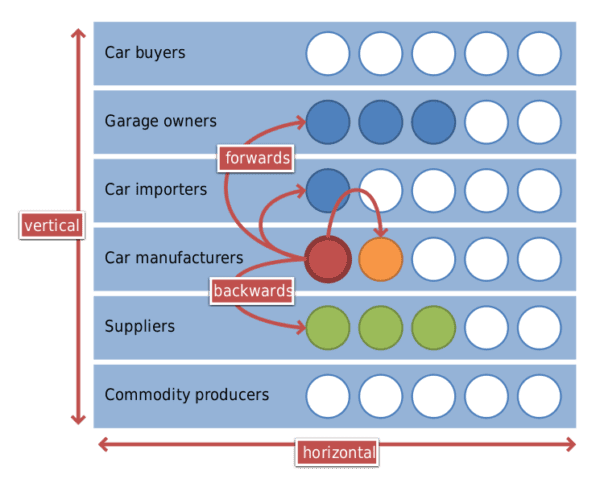Integration is a much sought-after capacity in today’s business world. Interestingly, it is also highly desirable from both an ecological and human development perspective. The integration of symbiotic species, organizational systems as well as fractured personalities empowers ecological, economical and personal potential. In essence, their combined success leads to a dramatic reduction in the risk of disintegrating outcomes such as —
• Disease-vulnerable ecosystems
• Species extinction
• Pollution of air, earth and water
• Errors, waste and rework
• Higher production and service costs
• Loss of customers
• Frustrated, disempowered employees
• Increased absenteeism and turnover
• Epidemic physical and mental illness
From an economic perspective, vertical integration typifies the management style of a company that “owns (and/or controls) its upstream suppliers and its downstream buyers.” For example, Apple’s software, services and hardware (manufactured to Apple specifications) are owned and sold by Apple directly to consumers through its retail stores. Thus, greater corporate independence and less supplier uncertainty are established.

Source by wikipedia.
Horizontal integration or expansion occurs when a company merges other companies from the same industry into its structure. These buy-outs and take-overs serve to expand market share or to monopolize a specific industry by providing cost advantages of both scale (reducing cost per unit of a single product) and scope (reducing cost per unit of two or more products). Such efficiencies and diversification reduce a company’s risk during economic downturns.
Human or personality integration adds another level of complexity for consideration. When one examines the sub-parts of any human being — SPICE (spiritual, physical, intellectual, communal and emotional) — the work to integrate all into one can be a lifetime exercise. To further complicate the contemporary human journey, Abraham Maslow theorized that self-actualized or integrated individuals need the following in their lives to be happy:
• Truth: honesty, reality, purity
• Goodness: desirability, uprightness, benevolence
• Beauty: rightness, form, simplicity
• Wholeness: unity, interconnectedness, organization, structure, synergy
• Dichotomy-transcendence: acceptance, resolution, integration
• Aliveness: spontaneity, self-regulation, full-functioning
• Uniqueness: idiosyncrasy, individuality, novelty
• Perfection: everything in its right place, just-rightness
• Necessity: inevitability, not changed in any slightest way
• Completion: ending, fulfillment
• Justice: fairness, suitability
• Order: lawfulness, rightness, perfectly arranged
• Simplicity: nakedness, abstract, bluntness
• Richness: differentiation, complexity, intricacy, totality
• Effortlessness: ease; lack of striving or difficulty
• Playfulness: fun, joy, amusement
• Self-sufficiency: autonomy, independence, self-determining
• Meaningfulness: purposefulness rather than senselessness
As if life were not complex enough, we are also faced with healing the disintegration of our ecosystem. Ecological integration can be described as “the scientific and biological consideration and organization of independent sub-systems of the ecology connected together in sequence and in conjunction with the greater whole.” The immediate benefits of such symbiotic relationships are “to correct for environmental damage and to control the complex demands of the human and urban metropolitan populations.” Simply put, there is no sustainable economy or human population without sustainable ecology.

Photo by bigfoto.
So where does one start to bring integration into being? Within our ecosystem? Within our companies? Within ourselves? Fortunately, it is not an all or nothing scenario and, as with all such “wicked” problems, we know we can accomplish nothing alone. Each of us must step forward from whatever platform we choose, gather our community together for support and focus our collective attention and energy on integration.
For myself, I initially chose the ecological and personal arenas through creating an urban garden where my body, mind and spirit could heal, grow and integrate. My neighbourhood responded in likeness creating a wonderful, stress-free residential oasis. Currently I am stepping back into the organizational realm where I am able to support the transformation of workplaces and employees into their fullest potential.
Throughout human history, the journey to integration mythologizes the hero’s journey. Such a passage requires the proverbial awakening to something more desirable, the shedding of past ways, then moving through a dark night of the soul and eventually surfacing as an integrated, authentic being. The heroic act of saving oneself necessarily expands to and encompasses others.
A more simplified version of this self-discovery and integration journey is highlighted in my poem below.
The Hero’s Journey
A hero’s story plays out within humanity, within you.
It tells a timeless tale of wonder, wounds and a wandering
pilgrimage in search for the holy grail of self.
Tho’ our mind may not choose this journey,
its path is hardwired into our souls.
Such great expectation demands collaboration.
We are joined whether foolishly or fortuitously
by those seeking to regain
the fearless wonder of childhood.
To once again glimpse within this Wonder Child
fills every heart to bursting.
So full of joy and imagination, confident it was you who
tumbled down the rabbit hole to outfox the Queen of Hearts.
Revealed as well, your less courageous, sometimes resentful
inner sibling watches from the shadows.
Aching to be seen, be touched, be loved, belong,
the Wounded Child wages an inner war of defiance.
The watchful Wanderer within gathers these
and many more pieces of self, whether brave or broken,
knitting each to the other. Compassionately,
smoothing ragged edges, washing sorrow with tears.
This Wanderer reforms without deforming
Until a face appears, the right face,
the face you have always known.
29 May 2012
What one heroic act can you offer to yourself? To your workplace? To your planet?





